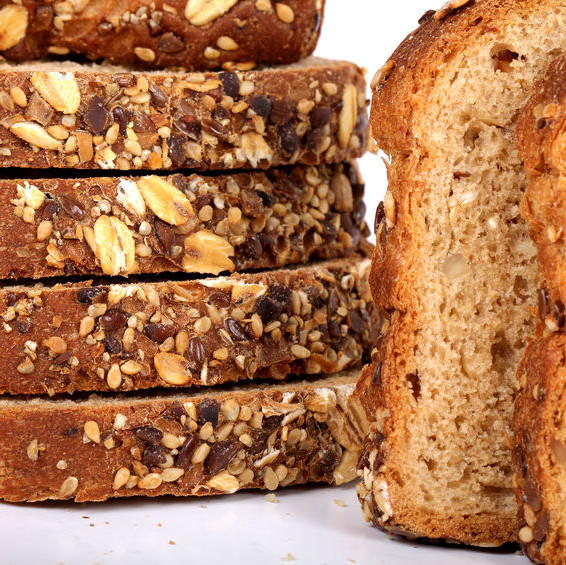How are variety breads made?
Variety pan breads differ from white pan bread in two ways:
- Variety breads are made with cereal flours which impart unique flavors, mouth feel, and aroma to the finished products.
- Wholemeal flours and clear flour mostly used in variety breads often contain higher levels of protein and ash, have darker colors and stronger flavors due to the presence of bran and aleurone.
Variety breads are typically produced using a straight dough or sponge and dough system.
The following table compares type and usage levels of variety bread flours to standard patent flour:
| Ingredient | Baker’s % |
| Bread flour (patent or white)* | 100.0 |
| Whole wheat flour** | 10.0–40.0 for wheat bread/100.0 for whole wheat bread |
| Rye flour (dark, medium or light) | 10.0–40.0 |
| Semolina flour | Any level (depending on particle size and desired dough properties) |
| Durum flour | Any level (depending on desired dough properties) |
| Cracked or crushed whole grains (ancient wheats, barley, corn, oats, rice, millets, triticale) | 10.0–30.0 (Or, any level depending on particle size and effect on dough’s properties) |
| Water | 60.0–85.0 |
| Compressed yeast | 1.0–5.0 |
* Protein content 12.5–14.0%, ash content 0.45–0.55% (depending on flour extraction and wheat class).
** Protein content >14.0%, ash content 1.5–2.0%.
Application
Considerations for grain flours used in variety breads:
- Whole grain flours are usually coarse (> 200 microns) with a wide particle size distribution which can impact water absorption and rate of hydration.
- Finely ground whole wheat flour hydrates at much faster rate coarse flours resulting in changes in mix time and potentially false impression of dough having high water content.
- Classes of wheat recommended for variety breads include Hard red spring (HRS), Hard red winter (HRW), Hard white (HW). A minimum level of damaged starch is required.1
- The absence or very low content of gluten-forming proteins in some grain flours, limits the amount of grain flour that can be incorporated into the bread dough.
- Dilution of gluten proteins due to presence of fiber and non-functional flours (flours that do not contain gluten-forming proteins) must be compensated for with vital wheat gluten to obtain a proper gluten matrix with good handling properties.1
FDA regulation
Whole wheat bread: According to the Standard of Identity, this product must be made with 100% whole wheat flour (no white or refined flour is to be used).2
Wheat bread: Unlike whole wheat bread, wheat bread only uses a portion of whole grain flour as this product does not have to comply with any legal requirements. It usually contains only 20–40% of whole wheat flour, the rest is usually refined or patent flour.
Whole grain bread: This product only uses whole grain flours. There is no Standard of Identity for this product.
Multigrain bread: Currently, there is no Standard of Identity in the US for multigrain bread. Several cereals and grains to provide flavor, color, or nutritional profile. To be multigrain, the bread should contain at least 3 grains (2 in addition to wheat).
Rye bread: Rye bread is made by using rye flour (dark, medium or light) or a combination of rye and refined wheat flour.
Fiber bread: Currently, there is no Standard of Identity in the US for fiber bread. It may contain soluble (inulin, beta-glucan) and/or insoluble(flax seed, chia flour or seeds) dietary fiber. Fiber enrichment involves replacing part of the white flour with whole grain flour, whole grains, bran, or other fiber-enriching ingredients that are available. Amount of fiber for health claims is set by the FDA.
Raisin bread: Raisin bread is a regulated product and must contain 50% raisins based on flour weight. Raisin juice concentrate does not count towards the percentage of raisins.2
References
- Finnie, S., and Atwell, W.A. “Products from Hard Wheat Flour.” Wheat Flour, 2nd edition, AACC International, Inc., 2016, pp. 91–110.
- Food and Drug Administration (FDA). US Department of Health and Human Services. CFR – Code of Federal Regulations Title 21, Part 136 Bakery Products, https://www.accessdata.fda.gov/scripts/cdrh/cfdocs/cfcfr/CFRSearch.cfm?CFRPart=136&showFR=1, Accessed 22 January 2019.

